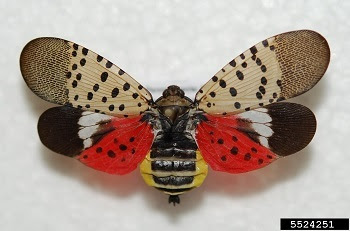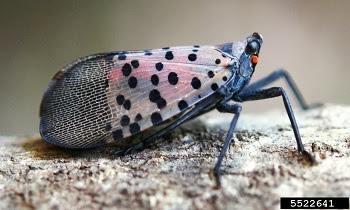| NOTE: This is a copy of a news release sent out earlier today from the Michigan Department of Agriculture and Rural Development.
For immediate release: September 15, 2021
Program contact: Robert Miller, (517) 614-0454
Media contact: Jennifer Holton, 517-284-5724
LANSING, Mich. – The Michigan Department of Agriculture and Rural Development (MDARD) is asking the public to be on the lookout for spotted lanternfly, an invasive insect with the potential to seriously affect Michigan’s agriculture and natural resources. This insect could damage or kill more than 70 varieties of crops and plants including grapes, apples, hops, and hardwood trees. To date, spotted lanternfly has not been detected in Michigan.
 First detected in the United States in 2014 in southeastern Pennsylvania, spotted lanternfly has been spreading rapidly across the northeastern states. There have been confirmed infestations in Connecticut, Delaware, Indiana, Maryland, New Jersey, New York, Ohio, Virginia, and West Virginia. First detected in the United States in 2014 in southeastern Pennsylvania, spotted lanternfly has been spreading rapidly across the northeastern states. There have been confirmed infestations in Connecticut, Delaware, Indiana, Maryland, New Jersey, New York, Ohio, Virginia, and West Virginia.
Spotted lanternfly causes direct damage by sucking sap from host plants and secreting large amounts of a sugar-rich, sticky liquid called honeydew. This honeydew and the resulting black sooty mold can kill plants and foul surfaces. The honeydew often attracts other pests like yellow jackets, flies, and ants, affecting outdoor recreation and complicating crop harvests. |
“Spotted lanternfly may be a colorful insect worthy of an Instagram post, but also is an invasive species with the potential to wreak havoc on trees, plants and other natural resources, resulting in millions of dollars in damages,” said Robert Miller, invasive species prevention and response specialist for MDARD. “In addition, it has the potential to impact grapes, stone fruits, apples and other crops in Michigan’s fruit belt as well as important timber species statewide.”
 From late summer to the first hard frost, spotted lanternflies are in their adult stage. Adults are roughly one inch long. Their folded wings are gray to brown with black spots. Open wings reveal a yellow and black abdomen and bright red hind wings with black spots transitioning to black and white bands at the edge. From late summer to the first hard frost, spotted lanternflies are in their adult stage. Adults are roughly one inch long. Their folded wings are gray to brown with black spots. Open wings reveal a yellow and black abdomen and bright red hind wings with black spots transitioning to black and white bands at the edge.
Adults are busy laying egg masses, which resemble old chewing gum, with a gray, waxy, putty-like coating. Egg masses can survive winter temperatures to hatch in the spring. Hatched eggs appear as brownish, seed-like deposits. Spotted lanternfly nymphs are wingless and are black with white spots, developing red patches in their final nymph stage. |
In November 2020, MDARD and the United States Department of Agriculture confirmed dead spotted lanternfly adults found in packing material at two separate locations in Michigan, demonstrating one of the many ways this insect could find its way into the state.
 Individuals and businesses receiving shipments from states known to have spotted lanternfly should also be on the lookout for adults or egg masses on goods and packing materials. Individuals and businesses receiving shipments from states known to have spotted lanternfly should also be on the lookout for adults or egg masses on goods and packing materials.
Recent discoveries of small populations in eastern Ohio and southern Indiana, indicate spotted lanternfly continues to encroach into the Midwest. With the current rate of spread, it is possible that spotted lanternfly could reach Michigan at any time. Public awareness and reporting are essential to early detection, which provides the opportunity to contain an infestation before it becomes a widespread problem. |
If you find a spotted lanternfly egg mass, nymph or adult, take one or more photos, make note of the date, time and location of the sighting, and report to the Michigan Department of Agriculture and Rural Development, [email protected] or phone the MDARD Customer Service Center, 800-292-3939. If possible, collect a specimen in a container for verification.
Before traveling, check out the map of confirmed spotted lanternfly locations. For additional information on identifying or reporting, visit Michigan.gov/SpottedLanternfly.
Michigan’s Invasive Species Program is cooperatively implemented by the Department of Environment, Great Lakes, and Energy, the Department of Natural Resources, and the Department of Agriculture and Rural Development.
/Note to editors: Accompanying photos are available below for download. Suggested captions and credit information follow:
SLF: The adult spotted lanternfly displays its colorful underwings and striped body when wings are open. Photo courtesy of Lawrence Barringer, Pennsylvania Department of Agriculture, Bugwood.org.
SLF folded wings: Spotted lanternflies are more likely to be seen with wings folded. Look for grey to brown wings with black spots, and black-striped wing tips. Photo courtesy of Lawrence Barringer, Pennsylvania Department of Agriculture, Bugwood.org.
SLF egg mass: Spotted lanternfly egg masses are gray to brown and resemble old chewing gum. Photo courtesy of Lawrence Barringer, Pennsylvania Department of Agriculture, Bugwood.org.
|





